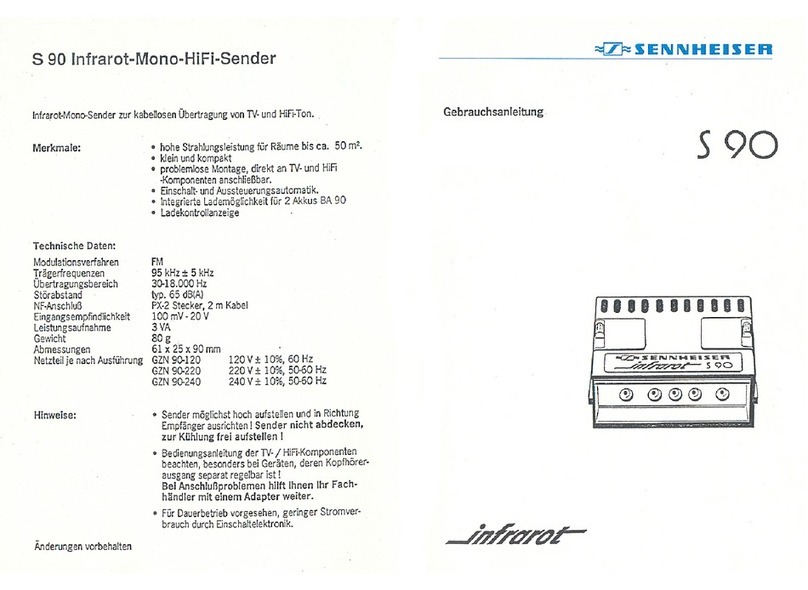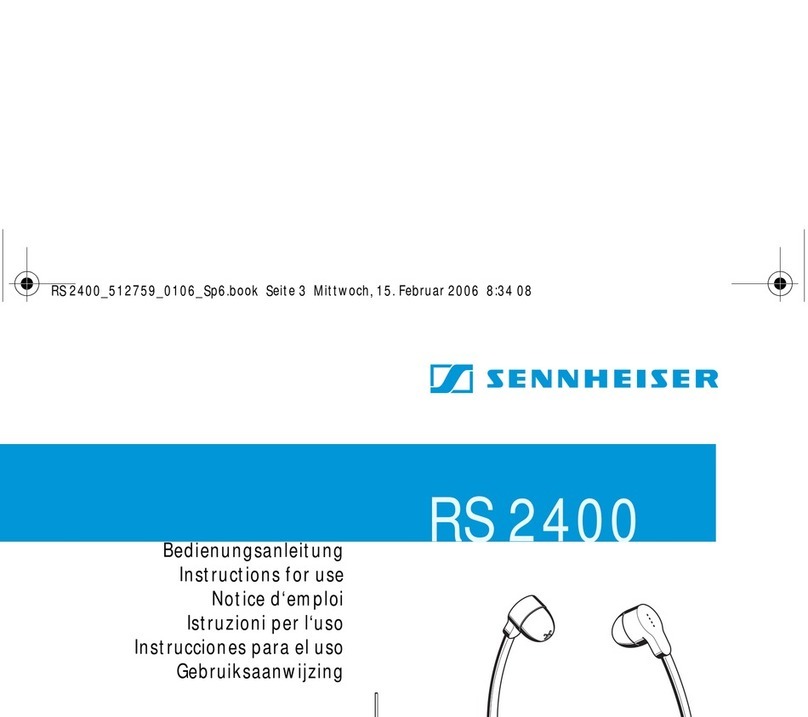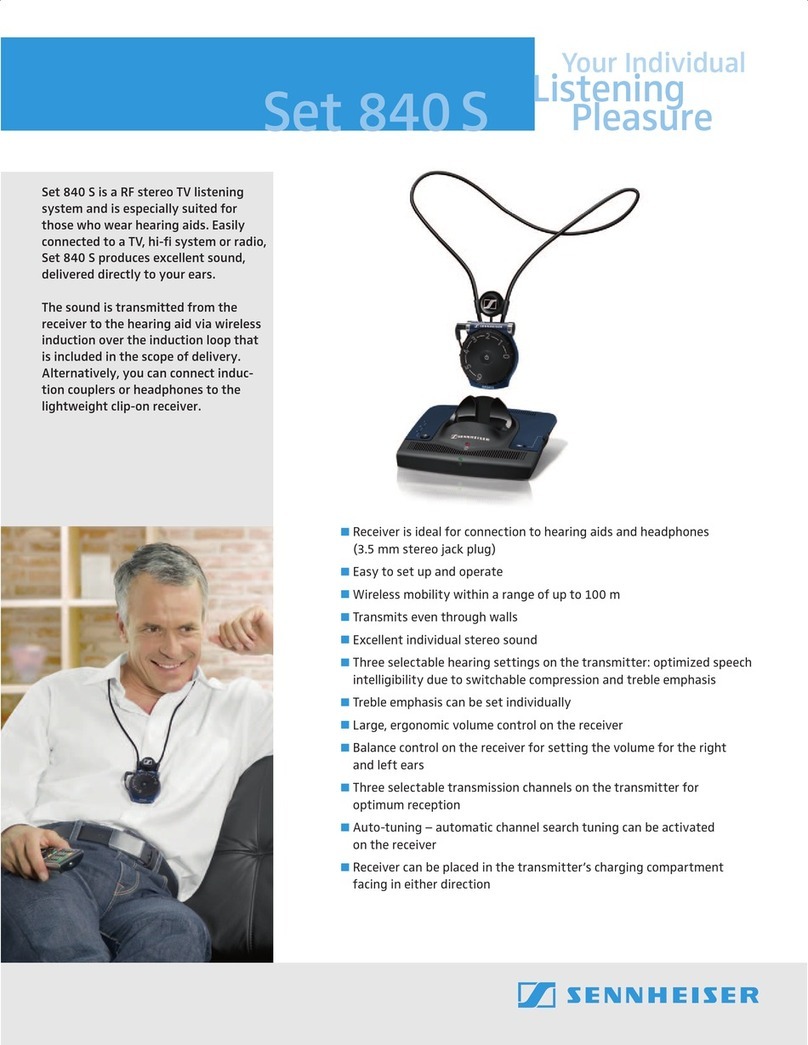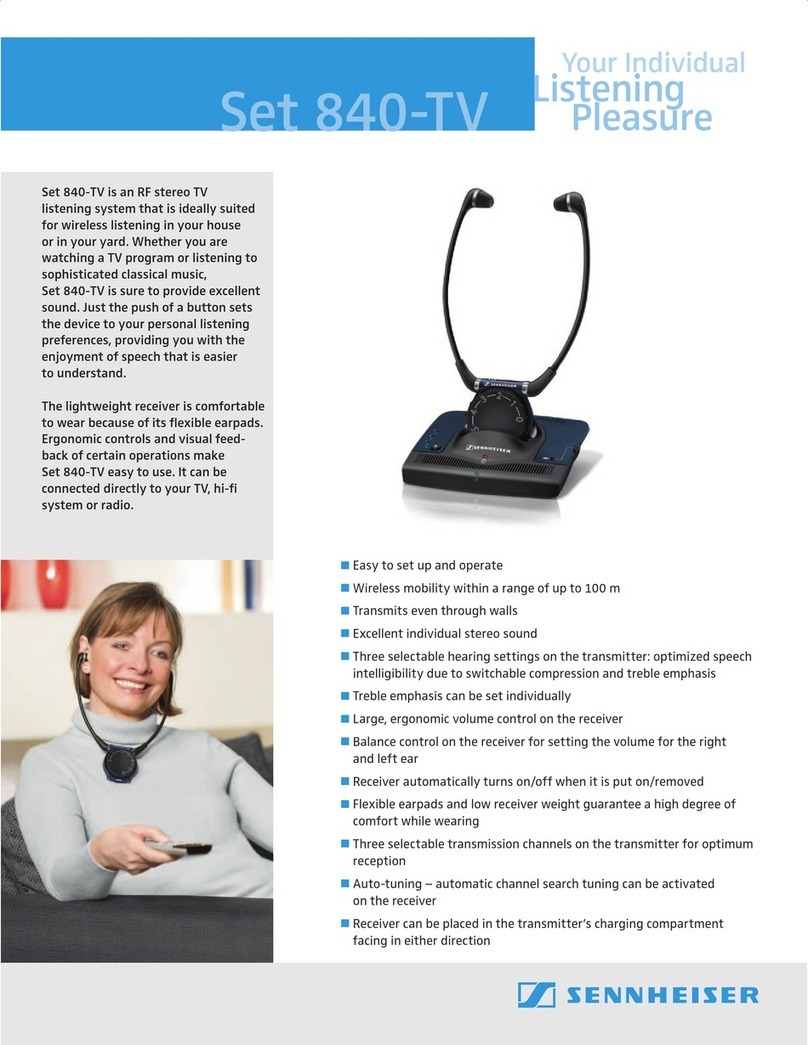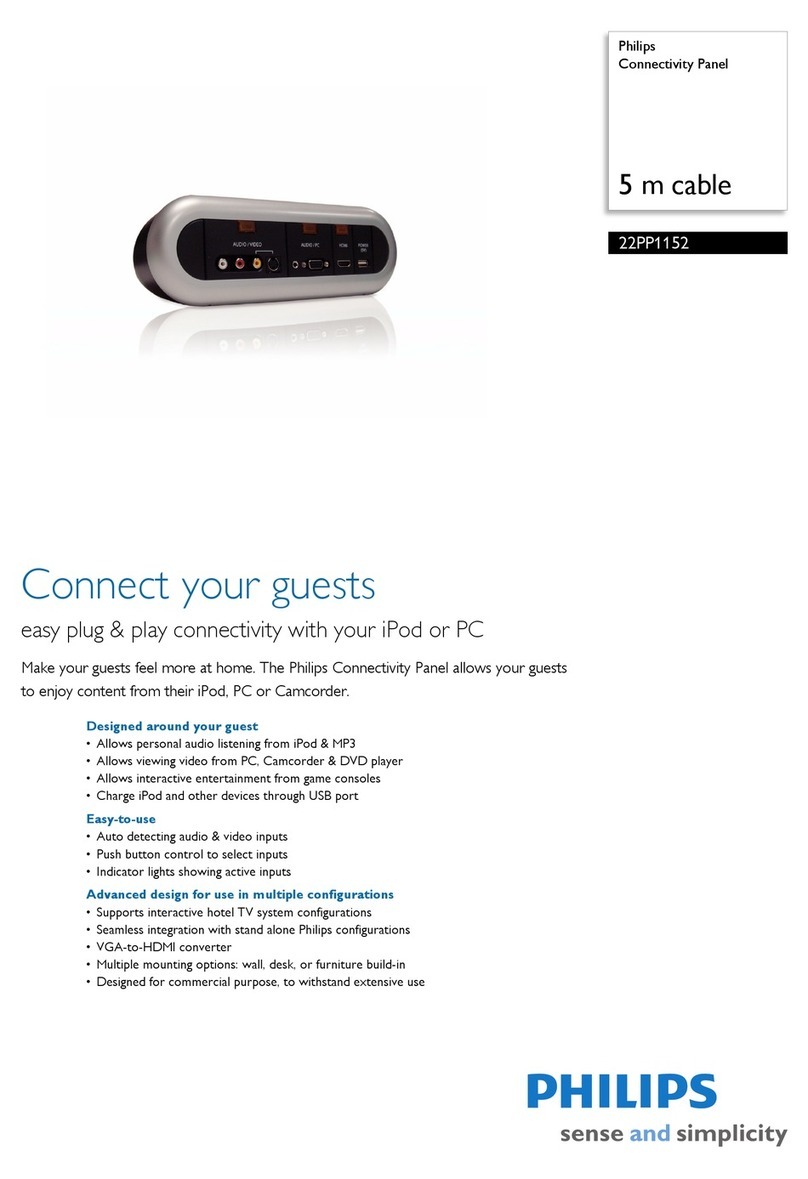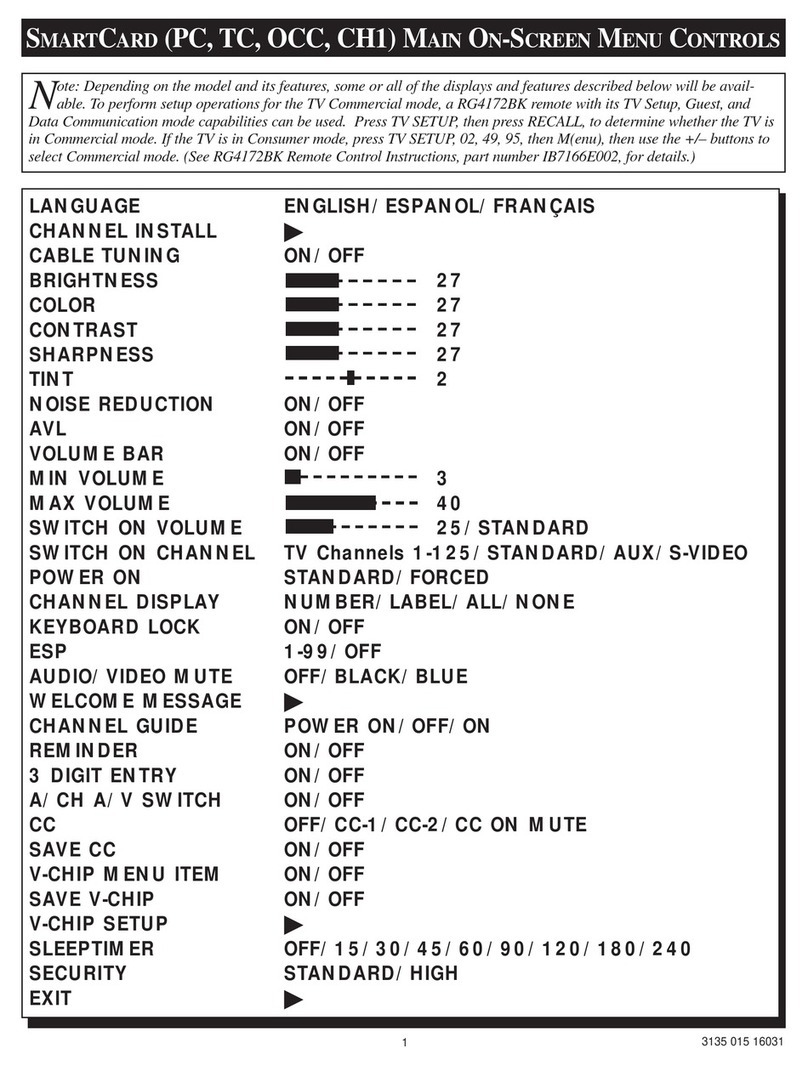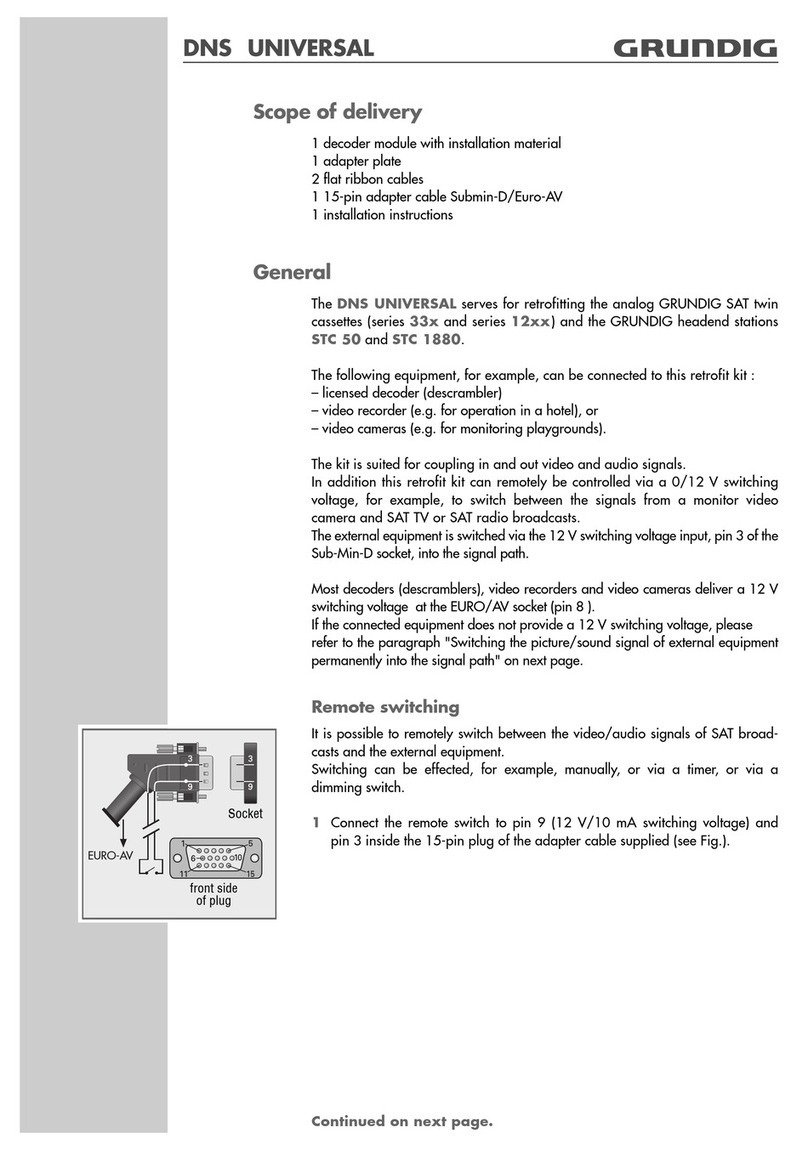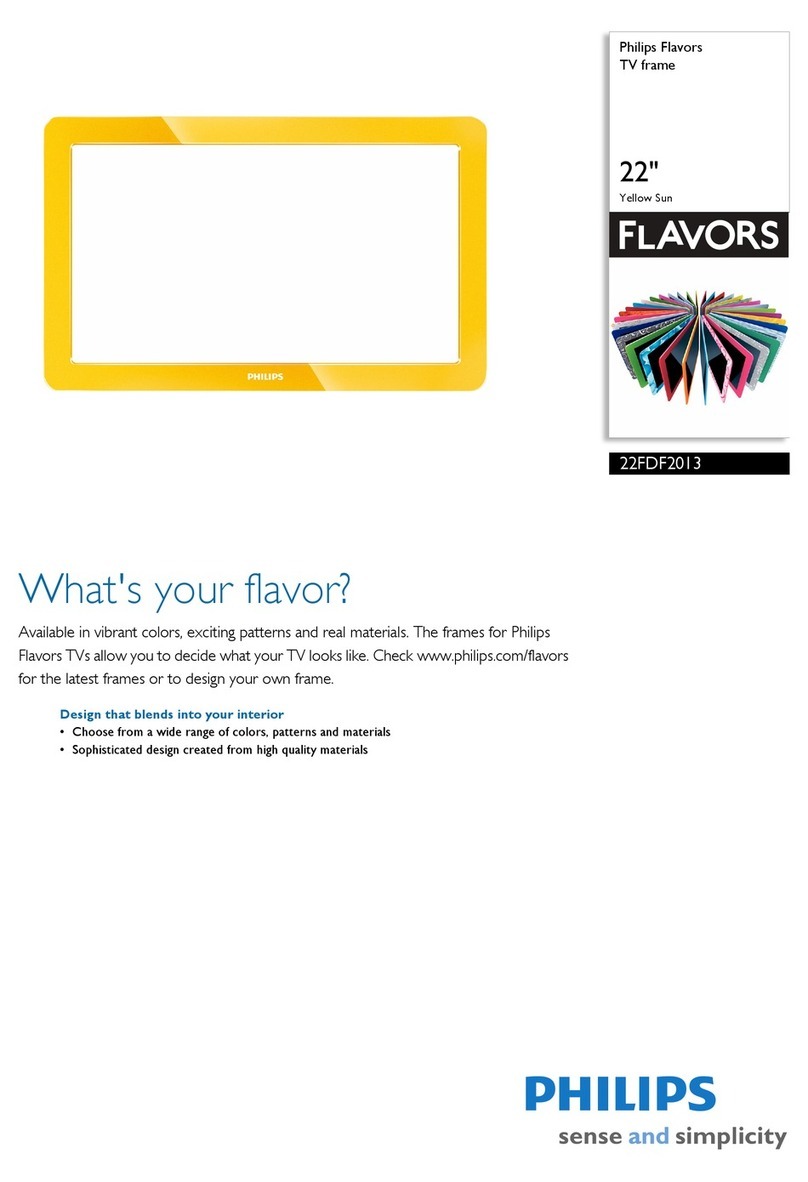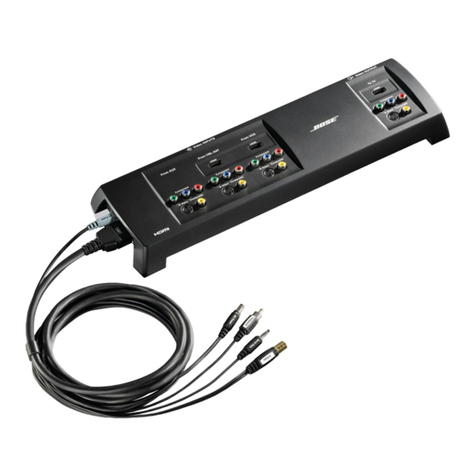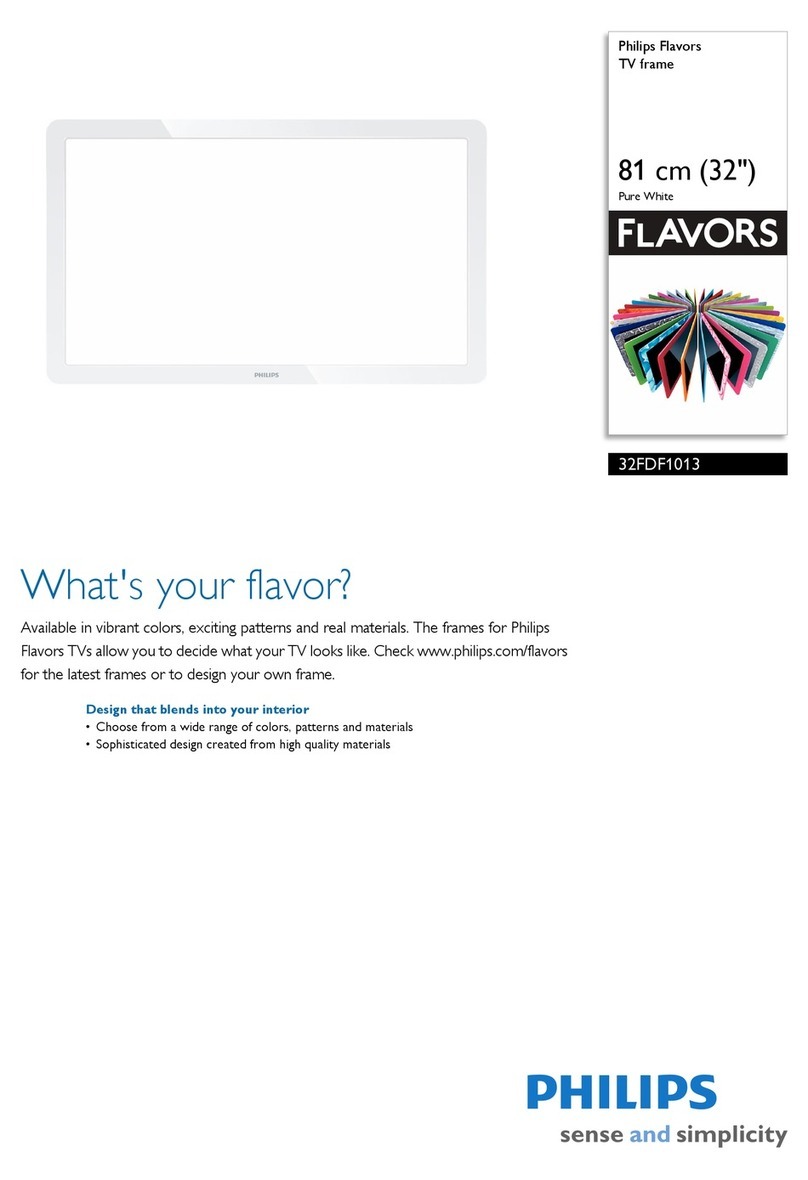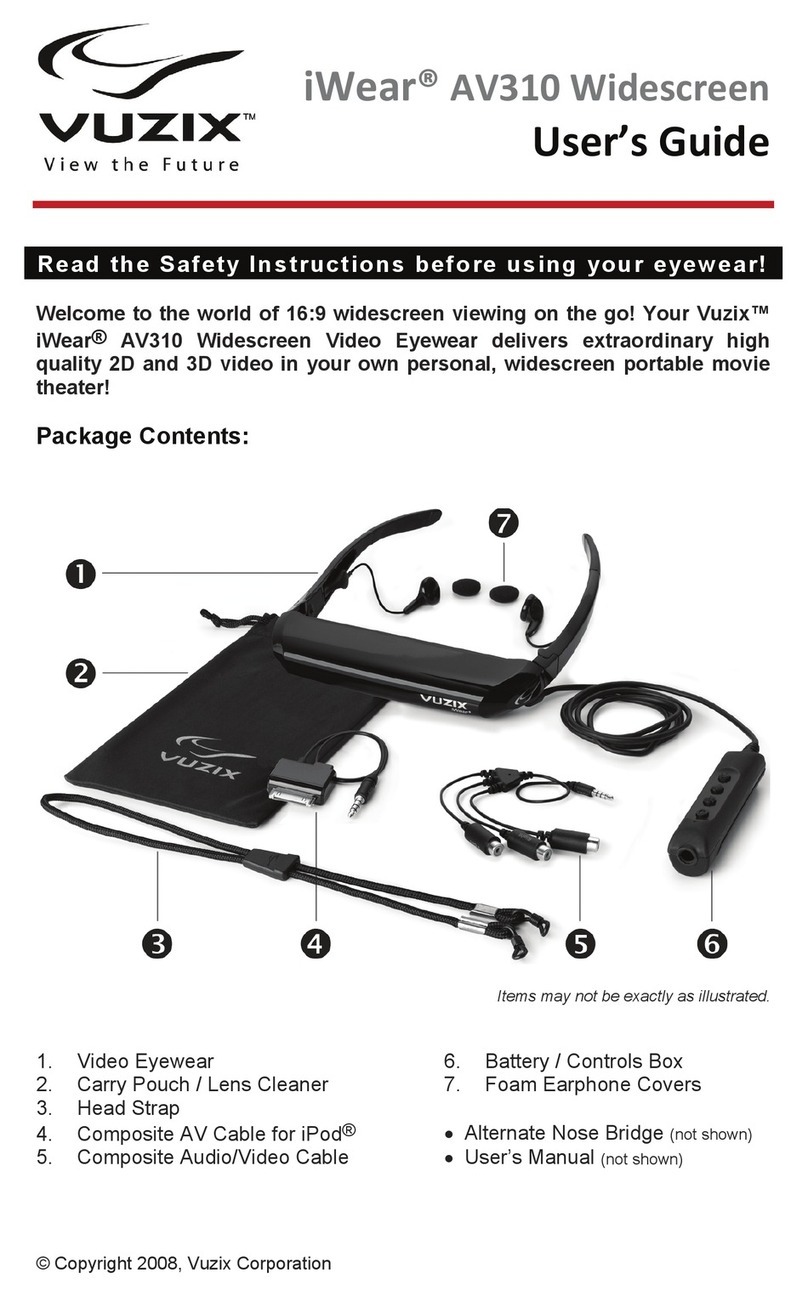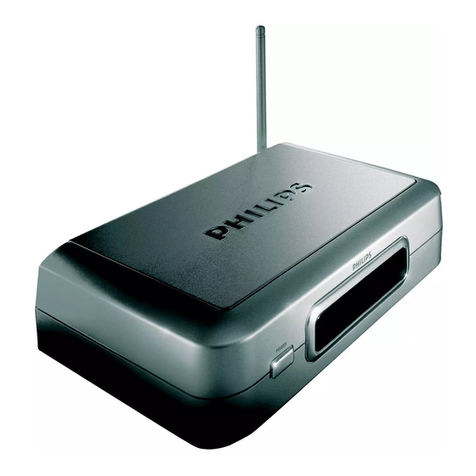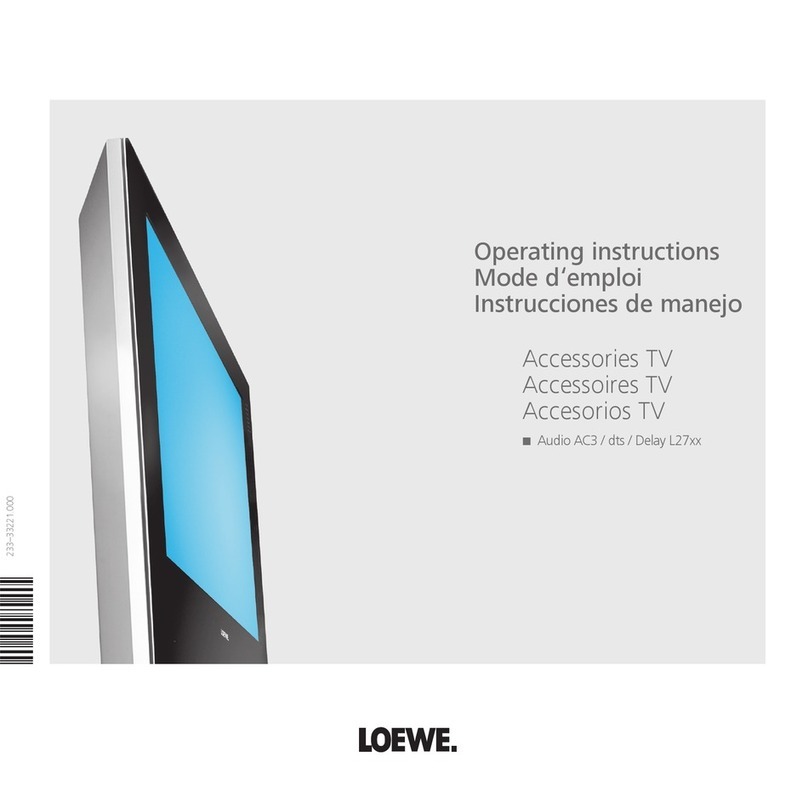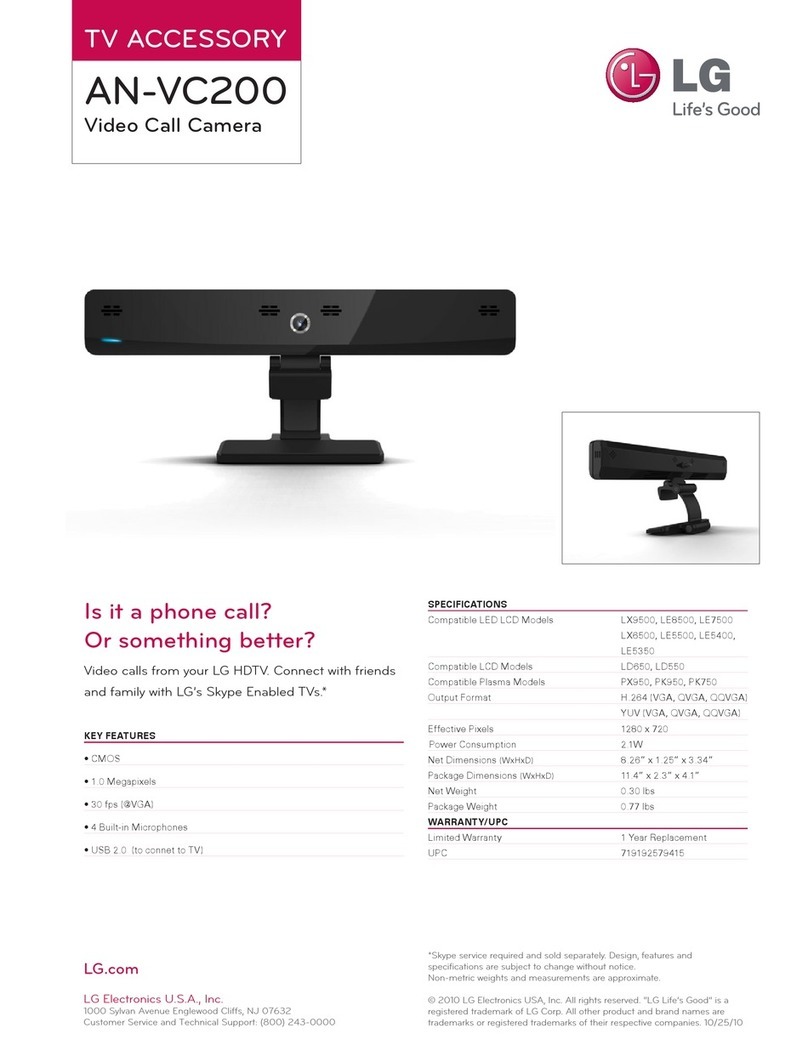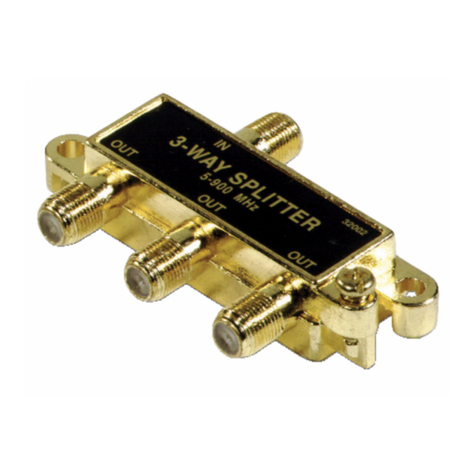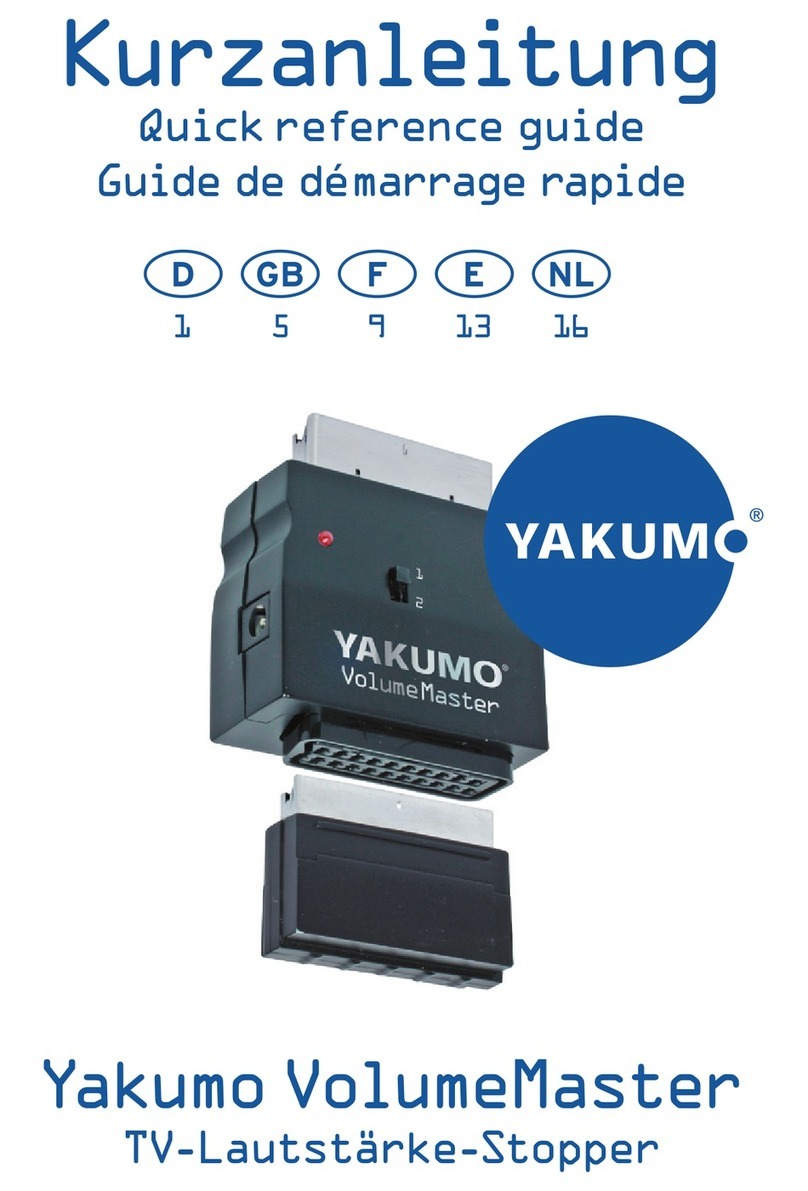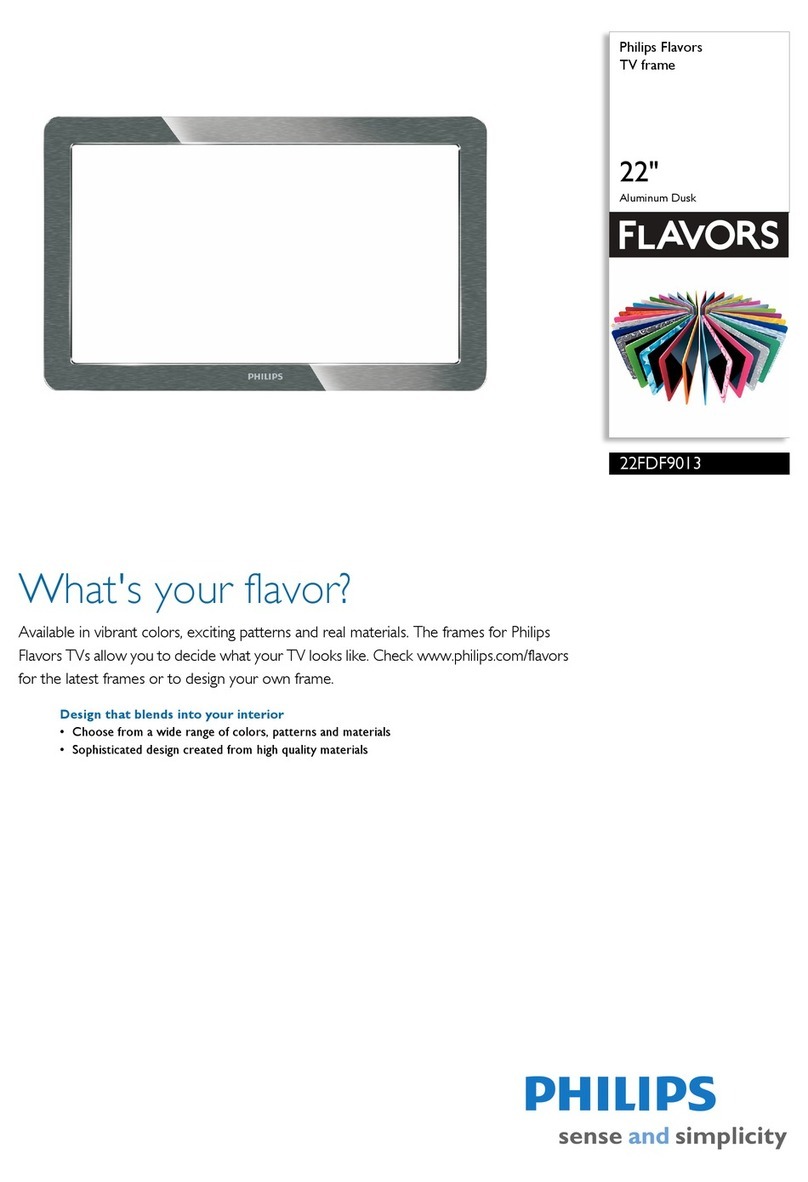Sennheiser SET 830 S - 04-09 User manual

Set 830 S
Cordless TV Listening System
Instruction manual

I
1
34
7
5
7
6
2
Q

II
D
C
9
8
0
A
H
G
F
E
B


1
Contents
Contents
Safety instructions ................................................................. 2
Delivery includes ..................................................................... 4
Product overview .................................................................... 5
Putting the Set 830 S into operation ................................. 6
Setting up the transmitter ............................................... 6
Connecting the transmitter to a sound source ............ 7
Connecting the transmitter to the mains ................... 10
Connecting headphones or the induction loop
for hearing aids to the receiver ..................................... 11
Wearing the receiver ....................................................... 12
Using the Set 830 S system ............................................... 14
Switching the transmitter on/off ................................. 14
Switching the receiver on/off ........................................ 15
Adjusting the volume ...................................................... 16
Searching for a sound source ......................................... 16
Adjusting the balance ..................................................... 17
Switching between mono and stereo operation ........ 17
Individually enhancing the speech intelligibility ....... 18
Storing and charging the receiver ................................ 19
Charging a rechargeable battery in the
transmitter’s charging compartment .......................... 20
What if... ................................................................................. 21
...this indicator lights up? ............................................... 21
...you press this button? ................................................. 21
...you change the position of this control/switch? .... 22
...you hear acoustic signals or warning signals? ........ 22
Cleaning the Set 830 S ........................................................ 24
Cleaning the transmitter and the receiver .................. 24
If a problem occurs ... ........................................................... 24
Additional technical information ...................................... 27
Fine adjusting the speech intelligibility ........................ 27
Changing the operating mode ........................................ 28
Accessories and spare parts ............................................... 30
Specifications ........................................................................ 32
Manufacturer Declarations ................................................. 34
Index ........................................................................................ 36

2
Safety instructions
Safety instructions
• Please read this instruction manual carefully and completely before
using the devices.
• Make this instruction manual easily accessible to all users at all
times. Always include this instruction manual when passing the
devices on to third parties.
• Do not use the devices in situations which require special attention
(e.g. when performing skilled jobs).
• Always keep the devices dry and do not expose them to extreme
temperatures.
• Use the devices with care and set them up in a clean, dust-free
environment.
• Varnish or furniture polish may degrade the feet of the transmitter,
which could stain your furniture. You should therefore place the
transmitter on a non-slip pad to avoid potential staining of
furniture.
• Connected headphones contain magnets that generate a magnetic
field which could cause dangerous interference with cardiac pace-
makers and implanted defibrillators. Keep connected headphones at
least 1.2” (3 cm) from cardiac pacemakers or implanted defibrilla-
tors.
• This receiver allows you to set higher volumes than conventional
headphones. This can cause hearing damage in persons with healthy
hearing and especially in children.
• Refer all servicing to qualified service personnel. Servicing is
required if the devices have been damaged in any way, liquid has
been spilled, objects have fallen inside, the devices have been
exposed to rain or moisture, do not operate properly or have been
dropped.
• WARNING: To reduce the risk of fire or electric shock, do not expose
the device and the mains unit to rain or moisture.
• Use only the supplied mains unit.
• Disconnect the mains connector from the wall socket
– to completely disconnect the device from the mains,
– during lightning storms or when unused for long periods of time.
• Ensure that the mains unit is
– always readily operable and easily accessible,
– properly plugged into the wall socket,
– not covered or exposed to direct sunlight for longer periods of
time in order to prevent heat accumulation,
– only operated within the permissible temperature range (see
“Specifications” on page 32),
– not operated near heat sources.

3
Safety instructions
Intended use
Intended use includes:
• having read this instruction manual, especially the chapter “Safety
instructions”,
• using the devices within the operating conditions and limitations
described in this instruction manual.
“Improper use” means using the devices other than as described in this
instructions, or under operating conditions which differ from those
described herein.
Safety instructions for the Lithium-Polymer rechargeable battery
The BA 300 is a Lithium-Polymer rechargeable battery. If abused or
misused, this rechargeable battery may be damaged. Please under-
stand that Sennheiser does not accept liability for damage arising from
abuse or misuse.
WARNING! In extreme cases, the rechargeable battery may even
present a
•heathazard
•firehazard
• explosion hazard
•smokeandgashazard
Do not heat above
70°C/158°F, e.g. do
not expose to sunlight
or throw into a fire.
Only charge rechargeable
batteries with the appro-
priate Sennheiser chargers.
Do not expose to
moisture.
When not using the
rechargeable battery for
extended periods of time,
charge it regularly (every
six months for about one
hour).
Do not short-circuit. Only charge rechargeable
batteries at ambient
temperatures between
10°C/50°F and
40°C/104°F.
Do not mutilate or
dismantle.
Do not charge the
rechargeable battery if the
device is obviously defec-
tive.
!Store the devices/
rechargeable batteries
in a cool and dry place
at room temperature.
Return defective devices or
exhausted rechargeable
batteries to your specialist
dealer.

4
Delivery includes
Delivery includes
Delivery of the Set 830 S system includes:
1 RI 830 S receiver
with BA 300 Lithium-Polymer rechargeable battery
1 TI 830 transmitter with integrated charging
compart-ments
1 EZT 3011 induction loop
1 NT 13 mains unit with
3 country adapters (EU, UK, US)
1 connection cable
with two 3.5 mm stereo jack plugs
for connection to a headphone socket
3 audio adapters:
1 adapter 3.5 mm to ¼“ (6.3 mm) jack plug
1 adapter for RCA socket
1 adapter for SCART socket
1lanyard
1 clip for attaching the receiver
1 instruction manual

5
Product overview
Product overview
The overview pictures of the receiver and the transmitter
can be found on the inside front cover of this instruction
manual.
Receiver
1Channel indicator
2Volume control
3On/off button
4Balance control
5Channel search button
6Battery compartment
7Socket for headphones,
induction loop or
connection cable to
hearing aid
Transmitter
8Charging compartment for receiver
9Charging compartment for optional spare rechargeable
battery
0Charging indicator for optional spare rechargeable
battery
ACharging indicator for receiver’s rechargeable
battery
BOperation indicator
C“Speech intelligibility” button
DIndicator for the selected speech intelligibility
ESocket (marked blue) for connection of sound source or
external microphone
FMono/stereo slide switch
GTreble adjustment control
HDC socket (marked yellow) for connection of mains unit
I
II

6
Putting the Set 830 S into operation
Putting the Set 830 S into operation
Setting up the transmitter
왘Place the transmitter so that:
– there are no obstacles in the light path between trans-
mitter and receiver and
– transmitter and receiver are not exposed to direct
sunlight. Direct sunlight may interfere with the recep-
tion and may damage the transmitter.
If you are using a plasma TV screen:
Plasma TV screens radiate an infra-red signal that can
adversely affect the transmission quality.
왘Make sure that the transmitter is placed as far as
possible from your plasma TV screen.
왘If necessary, use a standard extension cable (3.5 mm
stereo jack plug) to reduce the distance between trans-
mitter and receiver. This extension cable is available from
your Sennheiser dealer.
Note:
One transmitter can be used to transmit to several
receivers on the same frequency.

7
Putting the Set 830 S into operation
Connecting the transmitter to a sound source
왘Switch your sound source (e.g. TV) off before connecting
the transmitter.
왘Plug one end of the connection cable Iinto the blue
socket Eof the transmitter.
왘Check the available connection possibilities of your
sound source (e.g. TV).
왘Connect the transmitter as described in the corre-
sponding chapter , , or .
Note:
– If there are several connections ( , or ) avail-
able, select the SCART socket .
– SCART adapter and microphone are also available as
accessories (see page 30).
Connection possibility Name of connection possibility
Headphone socket
RCA socket
SCART socket
MKE 800 TV-N
external microphone
EI
A
B
LR
C
D
A
B
C
D
A
B
C
C

8
Putting the Set 830 S into operation
Connecting the transmitter to a headphone socket
왘Adjust the volume of the headphone socket on your
sound source to a medium level.
This improves the quality of cordless sound transmission.
For detailed information, please refer to the instruction
manual of your sound source (e.g. TV).
Note:
With most TVs, the headphone socket is located at the
front or sides.
Connecting the transmitter to an RCA socket
Notes:
– With most TVs, the RCA socket is located at the rear.
– If your TV has several RCA sockets, use the socket RCA
output.
왘Plug the other end of the connection
cable Iinto the head-phone socket
on your sound source.
Is the plug on the connection cable
too small for the headphone socket?
왘Plug the adapter to ¼“ (6.3 mm) jack
socket Jonto the connection cable.
왘Plug the adapter for RCA
socket K onto the connection
cable I.
왘Connect the red connector of
the adapter Kto the red RCA
socket Rof your sound source.
왘Connect the white connector of
the adapter Kto the white
or black RCA socket Lof your
sound source.
A
I
J
B
I
K

9
Putting the Set 830 S into operation
Connecting the transmitter to a SCART socket
Note:
If your TV has several SCART sockets, use the socket
SCART output.
Using the MKE 800 TV-N external microphone
What if your sound source doesn’t have any of the connec-
tions mentioned above?
You can then use the optional MKE 800 TV-N microphone
(see page 30).
What if your sound source mutes the external loud-
speakers if you use one of the connections mentioned
above?
왘Via the operating menu of your TV, check if the muting
can be deactivated.
왘If the muting persists, use the optional MKE 800 TV-N
microphone (see page 30) instead of the connection
cable.
To connect the MKE 800 TV-N microphone:
왘Directly connect the microphone to the blue socket Eof
the transmitter.
왘Position the microphone in front of the loudspeaker of
your sound source.
Note:
You can change the sound by varying the position of the
microphone in front of the loudspeaker.
왘Plug the SCART adapter L
onto the connection cable I.
왘Connect the SCART adapter L
to the SCART socket on your
TV.
C
L
I
D

10
Putting the Set 830 S into operation
Connecting the transmitter to the mains
– If there is no audio signal from the sound source
for about 3 minutes, the transmitter automatically
switches off. The operation indicator goes off.
왘Select the suitable country
adapter Nfor your wall
socket.
왘Slide the supplied country
adapter onto the mains
unit M.
왘Connect the yellow connector
of the mains unit to the yellow
socket Hof the transmitter.
왘Plug the mains unit Minto a
wall socket.
The operation indicator B
on the transmitter lights up
green.
Notes:
– When connecting the transmitter to the mains
for the first time, charge the rechargeable
battery for 3 hours as described in the chapter
“Storing and charging the receiver” on
page 19.
EU UK US
N
M
H
M
3h

11
Putting the Set 830 S into operation
Connecting headphones or the induction loop for
hearing aids to the receiver
The socket 7of the receiver allows you to connect
• the supplied induction loop Q,
• headphones or
• a connection cable to your hearing aid.
Connecting the induction loop
왘Carefully remove the clip Ofrom the receiver.
왘Attach the clip of the induction loop as shown.
왘Connect the induction loop Qto the socket 7of the
receiver.
왘Set your hearing aid to position “T”.
If your hearing aid has no position “T”, please contact your
hearing aid acoustician.
Note:
For alternative connection possibilities to your hearing
aid as well as the connection to cochlea implants, please
contact your hearing aid acoustician.
7Q

12
Putting the Set 830 S into operation
Connecting headphones
왘Connect the 3.5 mm jack plug of the headphones to the
socket 7of the receiver.
Wearing the receiver
In order to wear the receiver, you can use the supplied
lanyard P, the clip Oor the supplied induction loop Q.
The induction loop is suitable for users of hearing aids, the
lanyard and the clip are useful if you are using headphones.
Wearing the receiver around the neck
If you want to wear the receiver around your neck, use
• the supplied lanyard Por
• the connected induction loop Q(where applies).
To attach the lanyard P:
왘Connect the fasteners of the
lanyard Pto the metal ring at the
rear of the receiver.
왘Wear the receiver around your
neck, with the Sennheiser logo
facing away from your body.
7
P

13
Putting the Set 830 S into operation
Attaching the receiver to clothing or belt
If you want to attach the receiver to your clothing or belt,
use the attachment clip O.
To attach the receiver:
To remove the receiver:
왘Attach the clip Oto your clothing
or belt.
왘Pull the clip Owith the receiver
away from your clothing or belt.
O

14
Using the Set 830 S system
Using the Set 830 S system
To switch the Set 830 S system on, proceed as follows:
Switching the transmitter on/off
To switch the transmitter on:
왘Switch your sound source on.
The transmitter automatically switches on. The opera-
tion indicator Blights up green.
If the transmitter doesn’t switch on:
왘Read the chapter “If a problem occurs ...” on page 24.
To switch the transmitter off:
왘Switch your sound source off.
The transmitter automatically switches off after
3 minutes. The operation indicator Bgoes off.
To disconnect the transmitter from the mains:
왘Pull out the mains connector from the wall socket.
Note:
When not using the transmitter for extended periods of
time (e.g. when you are on holiday), pull out the mains
connector from the wall socket. In this case, however, the
receiver’s rechargeable battery will not be recharged.
Sequence of steps Page
1. Switch your sound source (e.g. TV) on.
The transmitter automatically switches on. 14
2. Adjust the volume on the receiver to a low
level. 15, 16
3. Switch the receiver on. 15
4. Adjust the desired volume on the receiver. 16

15
Using the Set 830 S system
Switching the receiver on/off
To switch the receiver off:
왘Press the on/off button 3until the channel indicator 1
goes off.
Hearing damage due to high volumes!
This receiver allows you to set higher
volumes than conventional headphones.
This can cause hearing damage in persons
with healthy hearing and especially in chil-
dren.
왘Before using the receiver, set the volume
on the receiver to a low level.
왘Do not continuously expose yourself to
high volumes.
To switch the receiver on:
왘Press the on/off button 3until the
channel indicator 1lights up.
The channel indicator 1goes off after
30 seconds.
Notes:
– For how to store and charge the receiver,
seepage19.
– If you are not within the range of the trans-
mitter, the receiver automatically switches off
after 3 minutes.
CAUTION!
1
3
3h

16
Using the Set 830 S system
Adjusting the volume
Searching for a sound source
왘Switch the receiver on.
Do you hear the desired sound source?
Yes: The receiver has already found the sound source.
왘If you have not yet found your sound source, press the
channel search button once more.
If you still cannot find your sound source:
왘Read the chapter “If a problem occurs ...” on page 24.
Note:
The channel indicator goes off after 30 seconds so
that the light won’t disturb you in a dark room.
왘Use the volume control
2
to
adjust
the volume to a sufficient and
comfortable level.
No:
왘Briefly press the channel search
button 5.
The sound source is searched for.
On the receiver, the channel indi-
cator 1can light up as follows:
Channel
indicator Frequency
You hear the
sound in
2.3+2.8 MHz stereo
2.,3 MHz mono
2.8 MHz
5
1
This manual suits for next models
5
Table of contents
Other Sennheiser TV Accessories manuals
